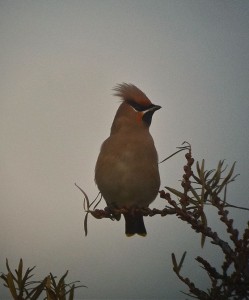Waxwings
These chubby yet gaudy wanderers from Scandinavia are being seen in their hundreds this winter, with big arrivals along the east coast in the autumn from mid October onwards. They have long been a birders’ favourite, often allowing close approach and appearing in otherwise bird-barren urban areas such as supermarket car parks.
I had the excitement of seeing a flock of 18 flying in over the shingle bank at Cley marshes NWT in early November, as well as singles over our office, 3 on survey in Perthshire and 1 over Norwich Cathedral yesterday. Those tuned in to their call will find that it’s not unusual to encounter the odd roaming singleton flying over in these irruption years.
Waxwings are an irruptive species, arriving in the UK in varying numbers each winter. The key driver to their movements would seem to be the supply of wild berries in Scandinavia. The 1965 irruption, according to Birds of the Western Palearctic, was a result of an “acute imbalance between population size and food supply in Fenno-Scandia”. An awesome set of photos from Fair Isle shows that birds crossing the North Sea were hungry enough to feed from the hand. Judging by the plethora of photos of waxwings appearing this autumn, once birds reach Britain, their favourite nosh would seem to be rowan berries, including ornamental varieties.
An interesting article in BirdGuides shows the movement through the country of a colour-ringed waxwing, from Orkney to Aberdeen in six days, and from Aberdeen to Cumbria in another seven. Previous patterns of invasion have shown that larger flocks tend to aggregate in city centres later in the winter, presumably because of the variety of food sources available.
And here’s the tenuous link; here is a piece of evidence that all the BREEAM assessments we undertake which recommend berry planting, and all the urban landscaping schemes which include berry-bearing shrubs and trees, do at least benefit this one species of bird in its hour of need. That is not to say that they do not benefit other birds in the same way. What sometimes seem like token efforts on small sites can cumulatively be of critical importance.
Rob

Robert Yaxley
Rob Yaxley started birdwatching at the age of 3 and saw his first waxwing in a garden in Costessey in 1985. Best memories including seeing a single waxwing in the trees at Guist Bridge in 1987, and hearing a flock go over while coppicing in Wayland Wood with the golden pheasants sometime in the early 1990s. Rob enjoys eating berries and hanging around in supermarket car parks.

